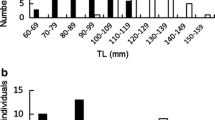Abstract
Social conditions and function of inter-group movement of females of the polygynous goby, Trimma okinawae, have been studied at Akamizu Beach, Kagoshima, Japan. Some females moved from their original groups, where the male was still present, to other groups. Before the movement females sometimes temporarily visited the group into which they subsequently moved, suggesting they were able to assess social conditions during the visit. By moving, the females increased in size rank or escaped from similar-sized female competitors in their previous groups. Although the social ranks of the moving females in their original groups were lower than those of the resident females, the ratio of the number of females that changed sex to the number of females surviving at the end of the study did not differ for the two types of female. Inter-group movement of females may increase the probability of their changing sex to become a dominant male.


Similar content being viewed by others
References
Aldenhoven JM (1986) Different reproductive strategies in a sex-changing coral reef fish Centropyge bicolor (Pomacanthidae). Aust J Mar Freshw Res 37:353–360
Buston PM (2003) Forcible eviction and prevention of recruitment in the clown anemonefish. Behav Ecol 14:576–582
Karino K (1996) Study methods of sexual selection in fishes: field observations, experiments and analyses. Jpn J Ichthyol 43:1–11
Kuwamura T, Nakashima Y (1998) New aspects of sex change among reef fishes: recent studies in Japan. Environ Biol Fish 52:125–135
Moyer JT, Zaiser MJ (1984) Early sex change: a possible mating strategy of Centropyge angelfishes (Pisces: Pomacanthidae). J Ethol 2:63–67
Munday PL, Buston PM, Warner RR (2006) Diversity and flexibility of sex-change strategies in animals. Trends Ecol Evol 21:89–95. DOI 10.1016/j.tree.2005.10.020
Muñoz RC, Warner RR (2003a) A new version of the size-advantage hypothesis for sex change: incorporating sperm competition and size-fecundity skew. Am Nat 161:749–761
Muñoz RC, Warner RR (2003b) Alternative contexts of sex change with social control in the bucktooth parrotfish, Sparisoma radians. Environ Biol Fish 15:307–319
Muñoz RC, Warner RR (2004) Testing a new version of the size-advantage hypothesis for sex change: sperm competition and size-skew effects in the bucktooth parrotfish, Sparisoma radians. Behav Ecol 15:129–136. DOI 10.1093/beheco/arg086
Nakazono A, Kuwamura T (1987) Sex change in fishes (in Japanese). Tokai University Press, Tokyo
Robertson DR (1972) Social control of sex reversal in a coral-reef fish. Science 177:1007–1009
Robertson DR, Warner RR (1978) Sexual patterns in the labroid fishes of the Western Caribbean, II: The parrotfishes (Scaridae). Smithson Contrib Zool 255:1–26
Ross RM (1990) The evolution of sex-change mechanisms in fishes. Environ Biol Fish 29:81–93
Ross RM, Losey GS, Diamond M (1983) Sex change in a coral-reef fish: dependence of simulation and inhibition on relative size. Science 221:574–575
Sakai Y (1997) Alternative spawning tactics of female angelfish according to two different contexts of sex change. Behav Ecol 8:372–377
Sakai Y, Kohda M, Kuwamura T (2001) Effect of changing harem on timing of sex change in female cleaner fish Labroides dimidiatus. Anim Behav 62:251–257. DOI 10.1006/anbe.2001.1761
Sunobe T, Nakazono A (1990) Polygynous mating system of Trimma okinawae (Pisces: Gobiidae) at Kagoshima, Japan with a note on sex change. Ethology 84:133–143
Sunobe T, Nakazono A (1993) Sex change in both directions by alteration of social dominance in Trimma okinawae (Pisces: Gobiidae). Ethology 94:339–345
Warner RR (1975) The adaptive significance of sequential hermaphroditism in animals. Am Nat 109:61–82
Warner RR (1978) The evolution of hermaphroditism and unisexuality in aquatic and terrestrial vertebrates. In: Reese ES, Lighter FJ (eds) Contrasts in behaviour. Wiley, New York, pp 78–101
Warner RR (1984) Mating behavior and hermaphroditism in coral reef fishes. Am Sci 72:128–136
Warner RR (1988) Sex change and the size-advantage model. Trends Ecol Evol 3:133–136
Warner RR, Robertson DR (1978) Sexual patterns in the labroid fishes of the Western Caribbean, I: The wrasse (Labridae). Smithson Contrib Zool 254:1–27
Warner RR, Swearer SE (1991) Social control of sex change in the bluehead wrasse, Thalassoma bifasciatum (Pisces: Labridae). Biol Bull 181:199–204
Acknowledgments
We are grateful to members of the Laboratory of Marine Biology, Kagoshima University, for their advice and encouragement during the study, and to Miguel Vazquez Archdale for his suggestions regarding the manuscript. We thank two anonymous reviewers for helpful suggestions and comments. This study is partly supported by a Grant-in-Aid for Scientific Research (C16570025) from Ministry of Education, Culture, Sports, Science and Technology, Japan.
Author information
Authors and Affiliations
Corresponding author
About this article
Cite this article
Manabe, H., Ishimura, M., Shinomiya, A. et al. Inter-group movement of females of the polygynous gobiid fish Trimma okinawae in relation to timing of protogynous sex change. J Ethol 25, 133–137 (2007). https://doi.org/10.1007/s10164-006-0007-y
Received:
Accepted:
Published:
Issue Date:
DOI: https://doi.org/10.1007/s10164-006-0007-y




